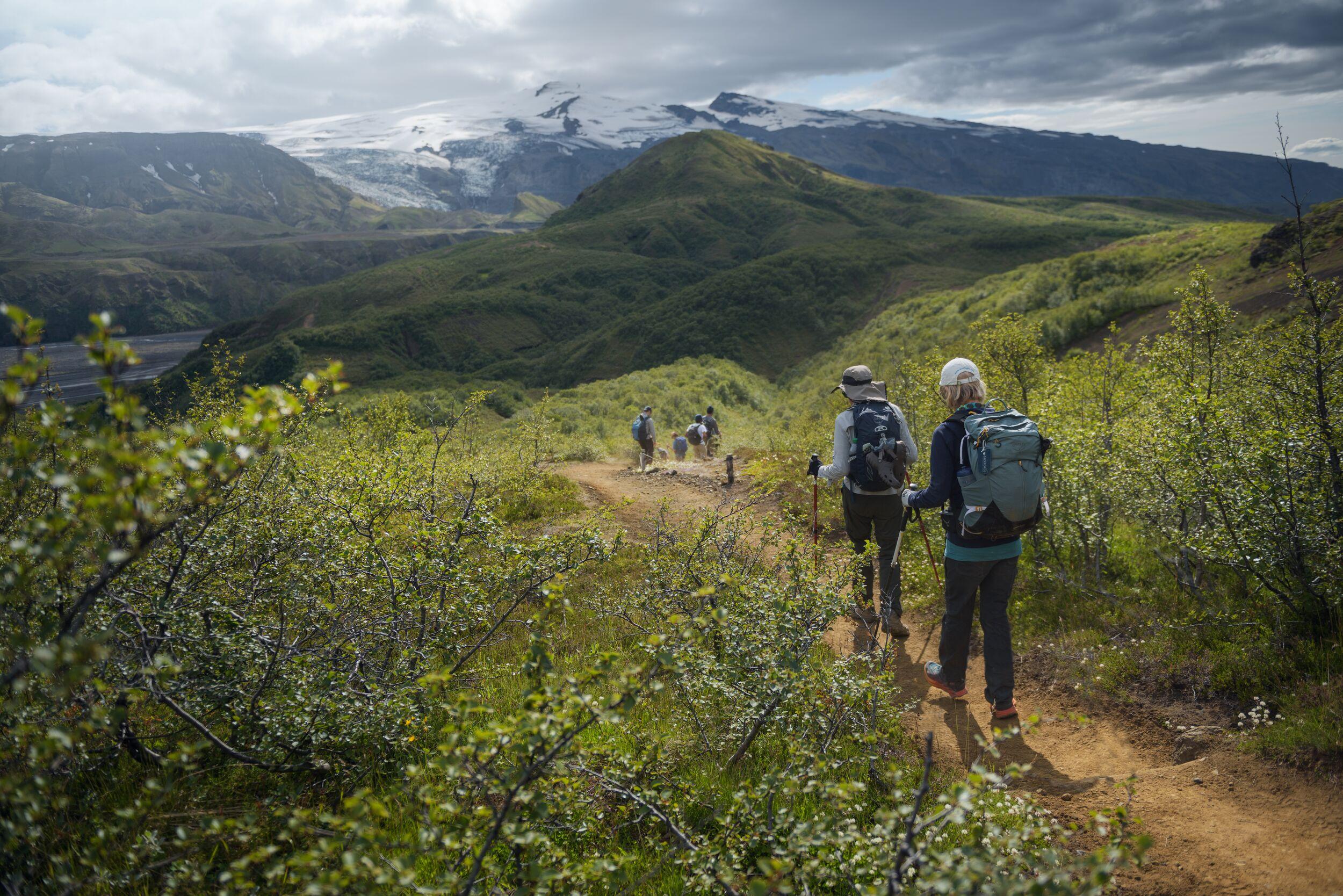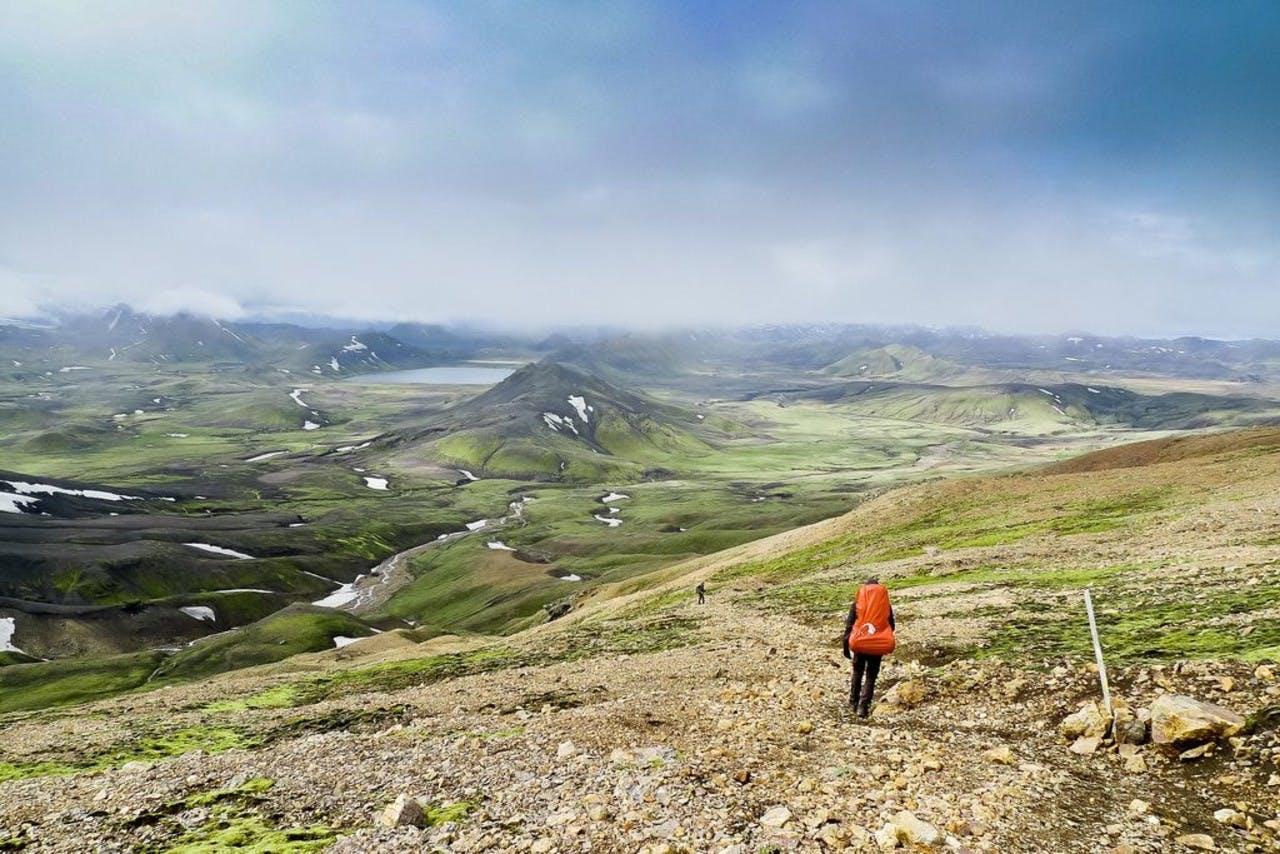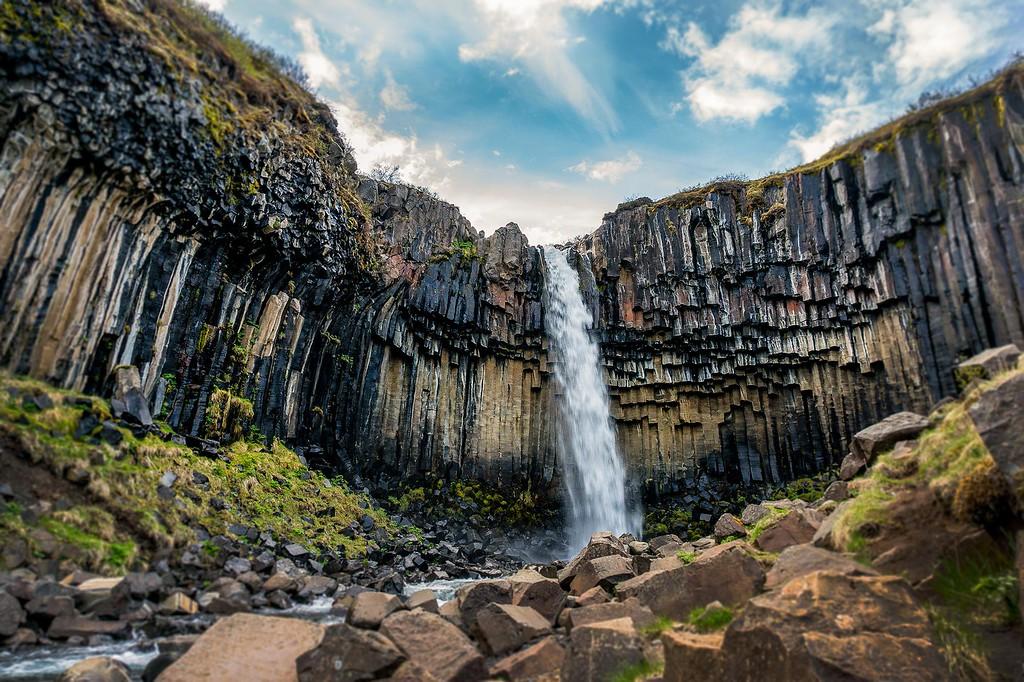The Ultimate List of the Best Hikes in Iceland
| All, DISCOVER ICELAND, Travel Guide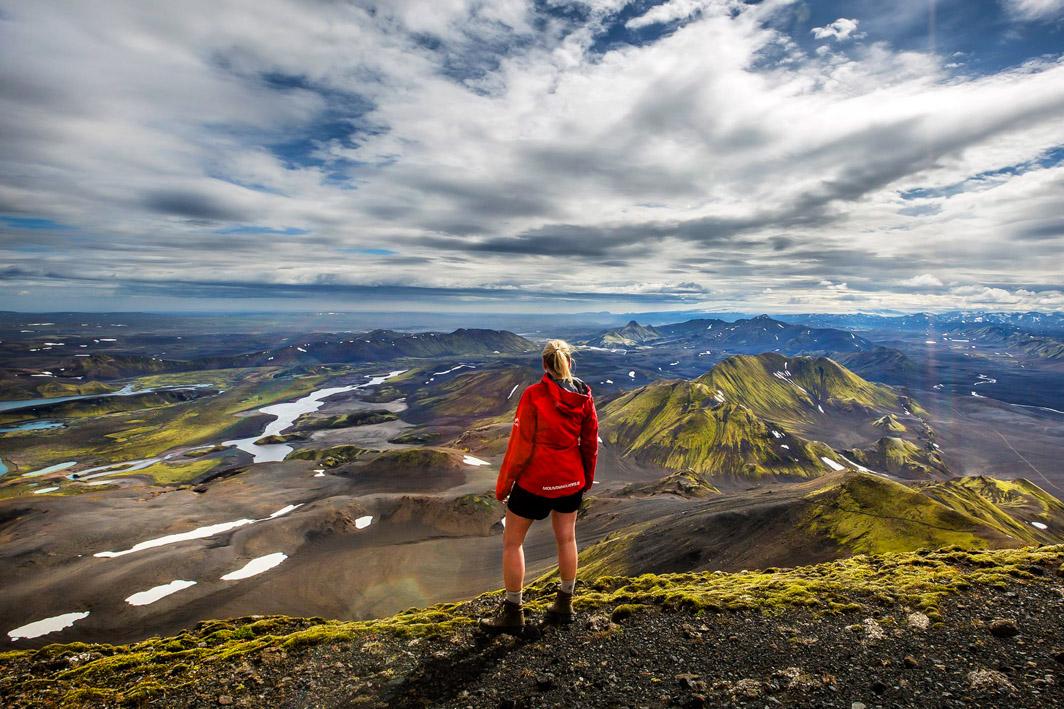
Iceland is consistently listed among the top 10 world-class hiking destinations, with National Geographic claiming Laugavegur and Fimmvorduhals Pass one of the best long-distance hiking trails on the planet. No wonder! In this largely uninhabited country, you’ll find thousands of kilometres of well-marked walking trails on which you’ll meet next to nobody.
But what is it that makes hiking in Iceland so thrilling? It’s the wide-open spaces, the pale northern light, and the raw beauty of vast wilderness that’s both humbling and awe-inspiring. It’s the otherworldliness of an island shaped by explosive volcanoes. It’s the living ground beneath your feet: smoking lava fields, spouting geysers, steaming geothermal rivers and lakes, snow-blinding ice caps and glaciers, mighty waterfalls, and the surreal colourful valleys. Hiking in Iceland is like no other place on this Earth.
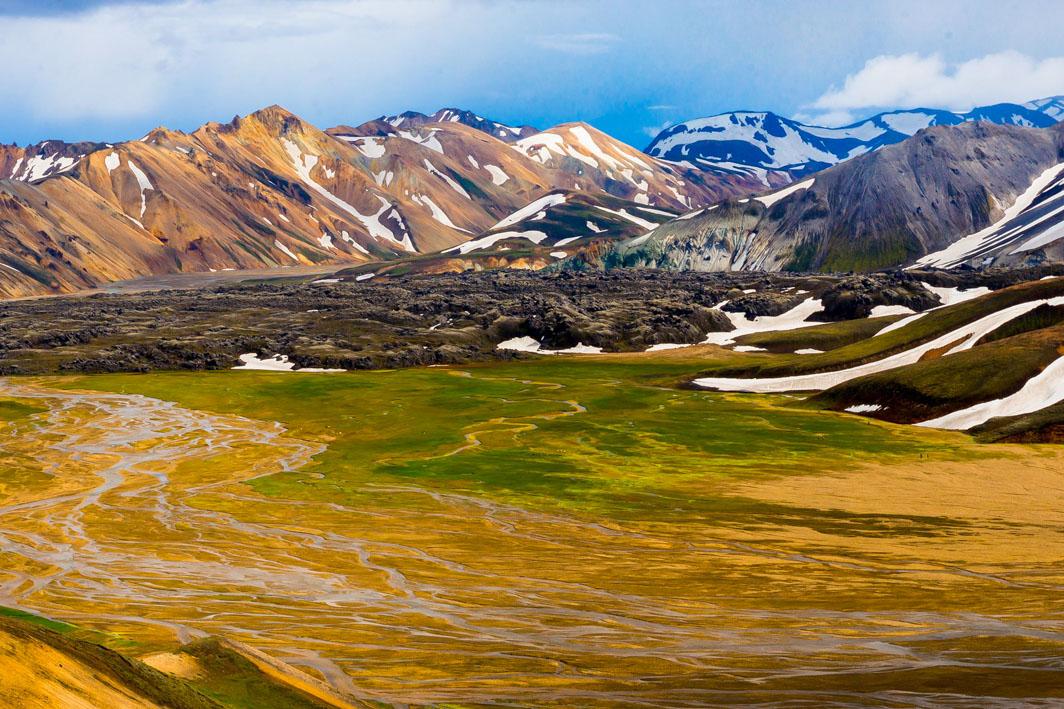
Landmannalaugar valley in summer
With such a variety of upland landscapes in Iceland, thrillingly shaped by volcanic action, every corner you turn will have a breathtaking vista. You’ll be able to combine straight-forward hikes with glacier trekking, ice cave and lava tunnel exploration, ridge walking, and ascents of Iceland’s highest snow-covered peaks with all the equipment for conquering ice and snow.
Let us guide you through this ultimate list of the best hikes in Iceland with Icelandic Mountain Guides. Here’s the lowdown.
Is hiking popular in Iceland?
Iceland is a country of wild, wide-open spaces, a major draw to the island. While road trips around the Golden Circle or Ring Road are popular, many people will leave their vehicles and hike up to waterfalls, glaciers, and geothermal rivers and pools or take coastal paths with great views of Iceland’s black beaches, sea stacks, and arches.
But more and more trekkers are discovering the Highlands, where nature is at its rawest. Here you can climb a peak and view an extraordinary volcanic world at your feet, tumble down a secluded canyon, or explore a glacier with a guide. Year after year, these high-level treks in the stark beauty of Iceland’s isolated fells are becoming increasingly popular.
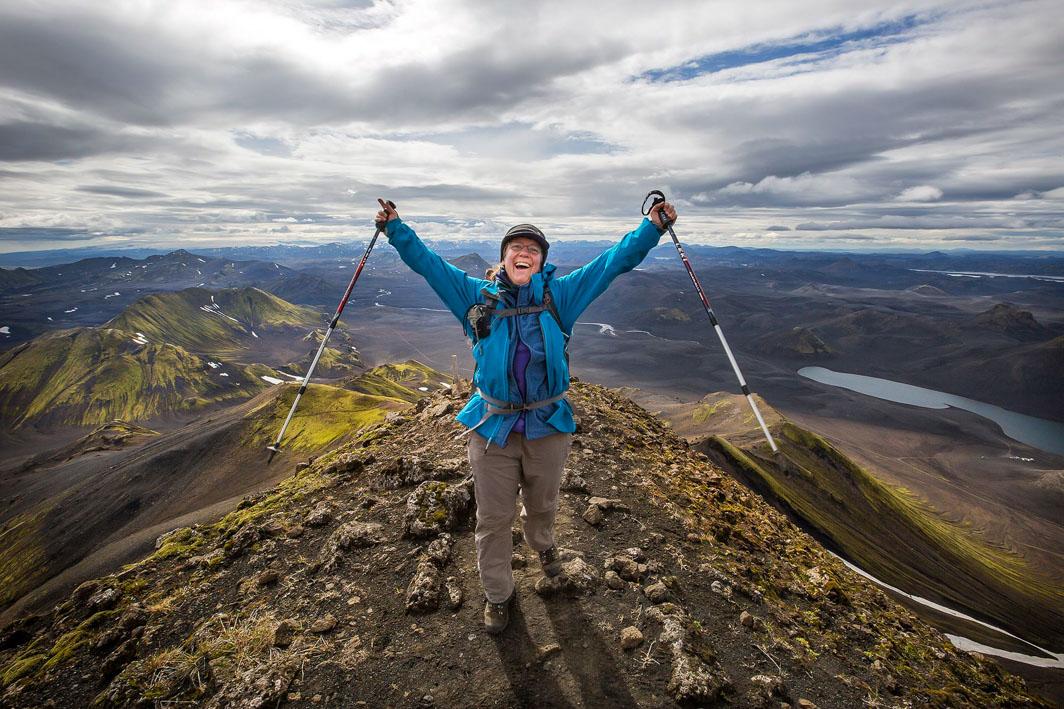
Hiking in Iceland is on the bucketlist of outdoorsy people all over the world
What fitness level do you need for hiking in Iceland?
It depends on what you want to do. There are hikes for every level of fitness in Iceland. If you have a base level of condition and can negotiate uneven ground, there’ll be a trek for you! Wander through Thingvellir National Park, hike a coastal path, or take one of the wide, even paths that gently ascend into the mountains. For an adventure of a lifetime - without needing the fitness of a wild mountain man - or woman - book an easy day tour with Icelandic Mountain Guides.
If you have an average to a good level of fitness and some experience in trekking, you’ll want to head deeper into the mountains and submerge yourself in the wilderness. Multi-day tours are the best way to do this with overnight stays in isolated huts. Traverse volcanic landscapes, a glacier or snowfield and climb a peak for panoramic views. Icelandic Mountain Guides offer some of the best multi-day packages.
For the more intrepid, you can conquer Hvannadalshnjúkur, at 2119 metres Iceland’s highest peak, cross Europe’s largest glacier of Vatnajökull or sign up to a 10-day cross-country ski expedition over the Highlands of Iceland, camping and staying in rustic huts. For these hardcore Icelandic adventures, you’ll need a high fitness level, resilience, strength, and climbing experience.
How to prepare for a hike in Iceland?
It’s simple: dress in lots of layers (with a thermal base), allowing you to remove the outer layers when you’re too hot climbing and add again when you’re on a windswept summit. Wear waterproof, ankle-supporting boots, thick socks and carry water, snacks, a phone, first-aid kit, map and compass. Find out more about mountain preparation with Icelandic Mountain Guides.

Some hikes are easy, while others are demanding but rewarding
Best time to hike in Iceland
When Is the Best Time to Hike in Iceland?
Summer is best when the trails are freer of deep snow, the days are long (you can fit in many hours of trekking) and the weather is kinder. Most guided tours only run in summer. A few winter hikes are offered, particularly if you want to visit the ice caves of the glaciers.
Is it possible to hike in winter?
The main issue with winter hiking is the extremely short days with around 3-6 hours of light. Many trails (and roads) are inaccessible because of deep snow. The weather conditions are challenging even if you make it onto the trails. Snowstorms or icy sleet and rain can arrive unexpectedly, and the wind on higher ground face-numbing. Winter climbing requires experience, technical know-how, and equipment - ice axes, crampons, and possibly ropes.
Some short, low-level walks are accessible, weather permitting: a hike to the Sólheimasandur plane crash, shorter hikes to waterfalls such as Svartifoss, or the low-level Thingvellir National Park. But you'll have to wait for summer for more exciting high-level full-day or multi-day treks.
We recommend joining a guided glacier hike tour for those who would like to hike and explore the Icelandic winter terrains safely. These hikes are safe and doable all year round, and there are many options, from easy to challenging. Check out these guided glacier hikes with Icelandic Mountain Guides, including a chance to explore stunning ice caves and a thrilling way to hike in winter.
Ice climbing is another adventurous thing to do all year round, but especially in winter. Check out this Introduction to Ice Climbing; it’s not only thrilling, but it also tones muscles, increases flexibility and balance, and it improves your fitness levels.
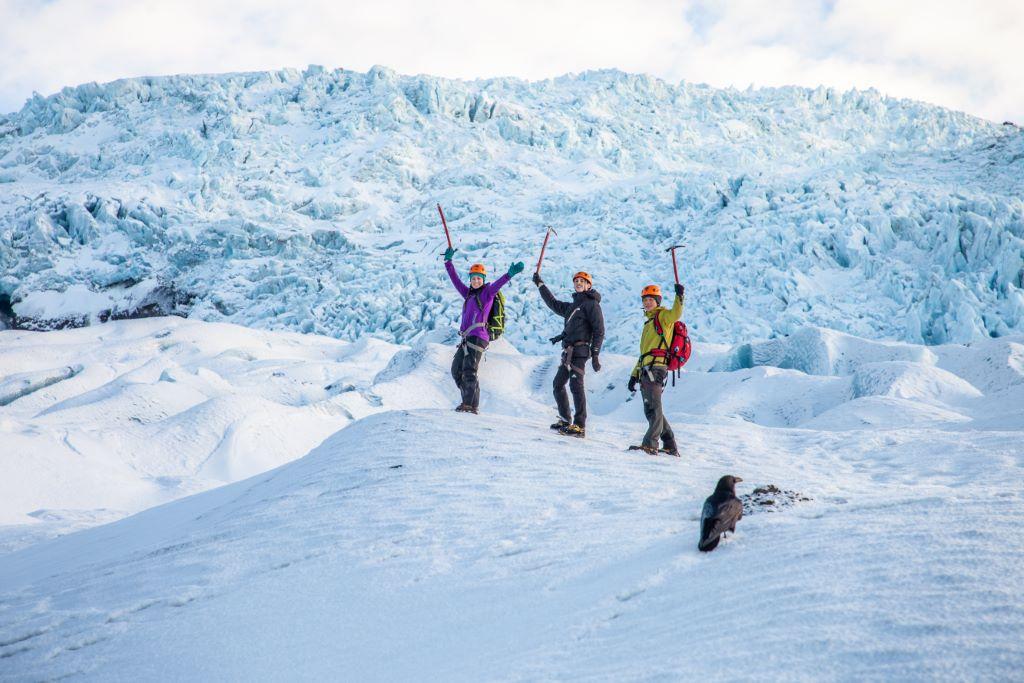
Guided glacier hiking on the stunning Falljökull glacier
Trail conditions in spring and autumn
In spring, many popular trails are closed due to the muddy conditions brought about by snowmelt and thaw, risking life and limb. River levels rise in springtime, adding another risk to slip injuries and falls. Trails may also be closed to protect delicate vegetation. Having said that, the days are growing ever longer, and the ground is springing back to life with wildflowers in May. Coastal walking is thrilling, with bird colonies busy nesting. Puffins can be experienced from mid-April on the Látrabjarg cliffs of Iceland’s Westfjords, the Westman Islands, and on the south coast around Reynisfjara and Dyrhólaey.
Autumn (beginning in September, really) offers last-chance walking in places such as the Highlands. September and October paint a more muted canvas of browns and rusts, and the days are still relatively long. But remember, the weather is especially changeable at this time of year. Always check the forecast before you set out.
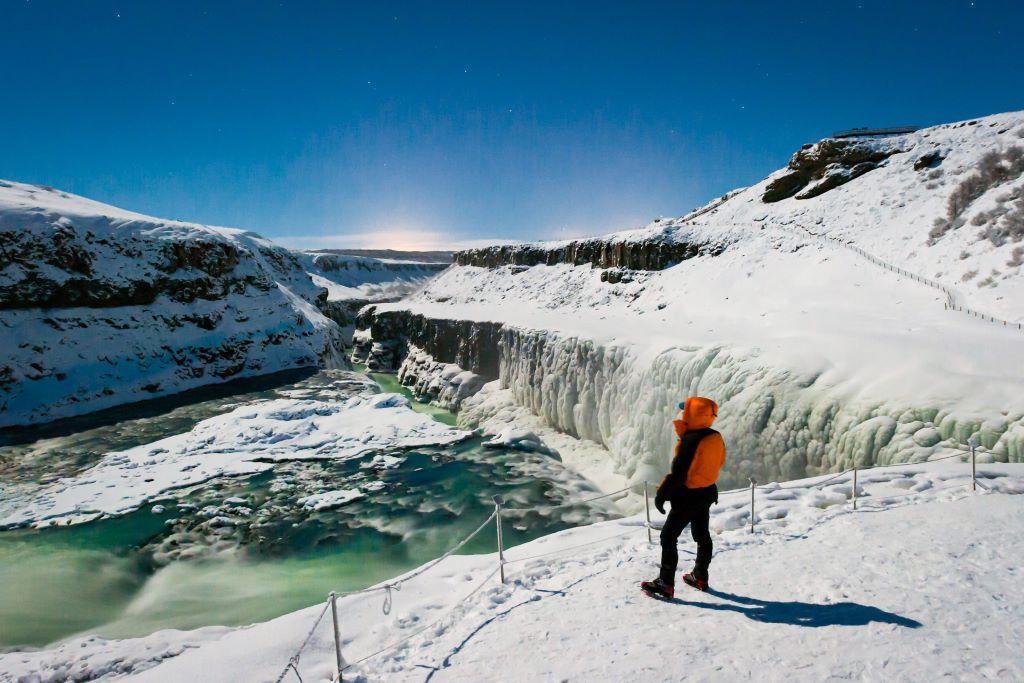
Spring arrives later than in most of Europe, snow usually doesn't melt before late April
Iceland’s Most Beautiful Hiking Areas and Trails
The Best Hikes in the Icelandic Highlands
Hiking trails in Thórsmörk
Contrasting the dazzling white of glacial ice with the dark green of mossy valleys, this four-day trek of Thórsmörk Glacier Valley - named after Thor, the god of thunder - is a thrilling adventure over the last and most beautiful part of the Laugavegur Trail up to Fimmvörðuháls Pass.
Stay in a mountain hut, traverse rivers, climb through mountain terrain, and trek alongside the glacier. Where three glaciers meet - Eyjafjallajökull, Mýrdalsjökull, and Tindfjallajökull - your guide will reveal secret canyons, caves, and craters.
There are myriad hiking trails in Thórsmörk; if you want to explore the best ones, book your 4-Day Thorsmork Glacier Valley Hiking Adventure with Icelandic Mountain Guides. Meals are included, along with a celebratory BBQ on the last night.
Difficulty: Moderate to challenging
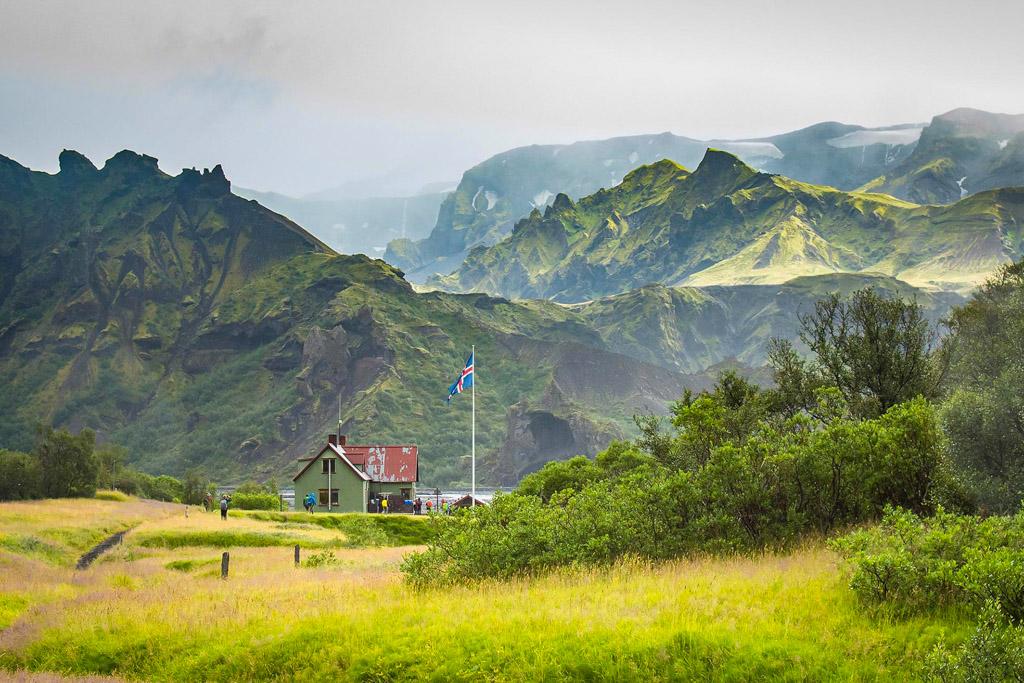
Mountain hut in Thórsmörk
Fimmvörduhals trail
Start this day-long trek at the 60-metre-high waterfall of Skógafoss. Along the trail, you’ll pass another twenty-six falls, the route leading between the glaciers of Eyjafjallajökull and Mýrdalsjökull. Marvel at the otherworldly landscape of Móði and Magni - the lava fields and volcanic craters formed from the 2010 eruption of Eyjafjallajökull. From the highest point, the trek descends through Thórsmörk Valley with views of Iceland’s uplands, its volcanic mountains thrusting out of a rock-strewn and moss-covered landscape. It’s no wonder National Geographic named the trail one of the best hikes in the world.
Book the Fimmvörduhals Day Hike with Icelandic Mountain Guides.
Difficulty: Demanding (Demanding some effort and endurance. Good health and some hiking experience is required. 6-8 hours walk per day. Often involves carrying your own gear.)
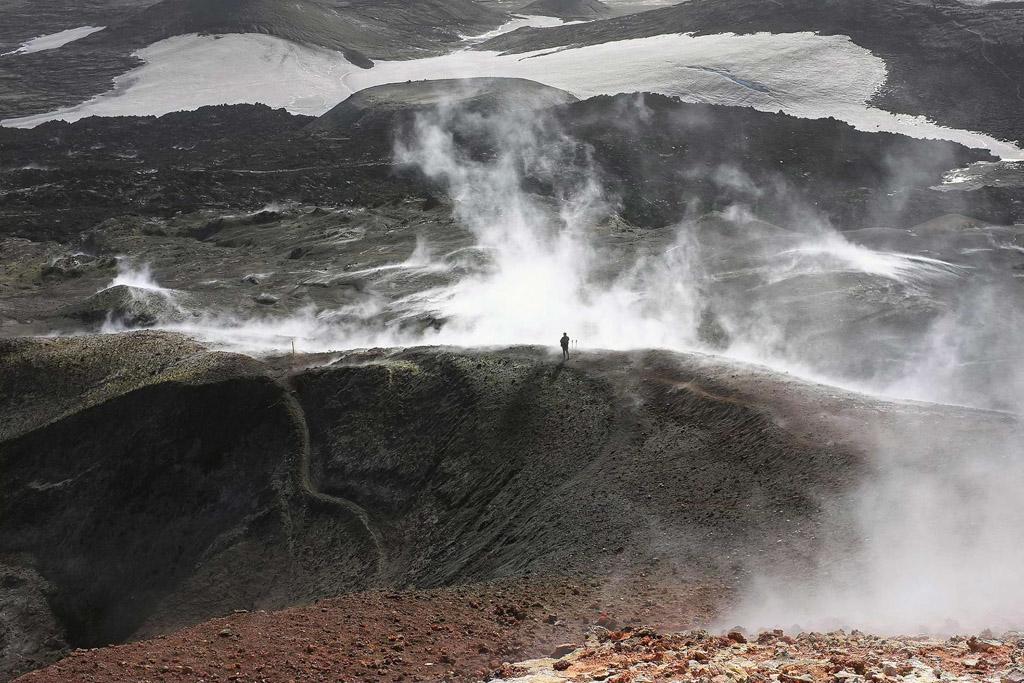
The ground around the Fimmvörduháls pass was still smoking a few years ago
Landmannalaugar
How do you explain the unearthly colours of Landmannalaugar’s landscape? If you’d like the scientific explanation, it’s the chemical reactions in the volcanic processes that erupted these rhyolite lavas. Rare in Iceland (the most silica-rich of volcanic rocks), rapid cooling and oxidisation of iron in the rhyolite gives Grænihryggur (meaning green ridge) its vivid green colour. But you don’t need to understand the chemistry of the volcanic activity to appreciate the blinding fluorescent greens, reds, blues, and yellows of this awe-inspiring area.
There are plenty of well-marked paths in Landmannalaugar, from short and easy ones to long and challenging climbs. The most popular ones are Bláhnjúkur: The Blue Peak Trail, Ljótipollur: The Ugly Puddle Trail, the Grænagil-Laugavegur Loop, and of course there are the multiday treks, such as the Laugavegur and the Sprengisandur Route. Our top favorite day hike in this area is the unique Green Ridge Hike Reserve your spot as soon as possible!
Difficulty: Easy to challenging
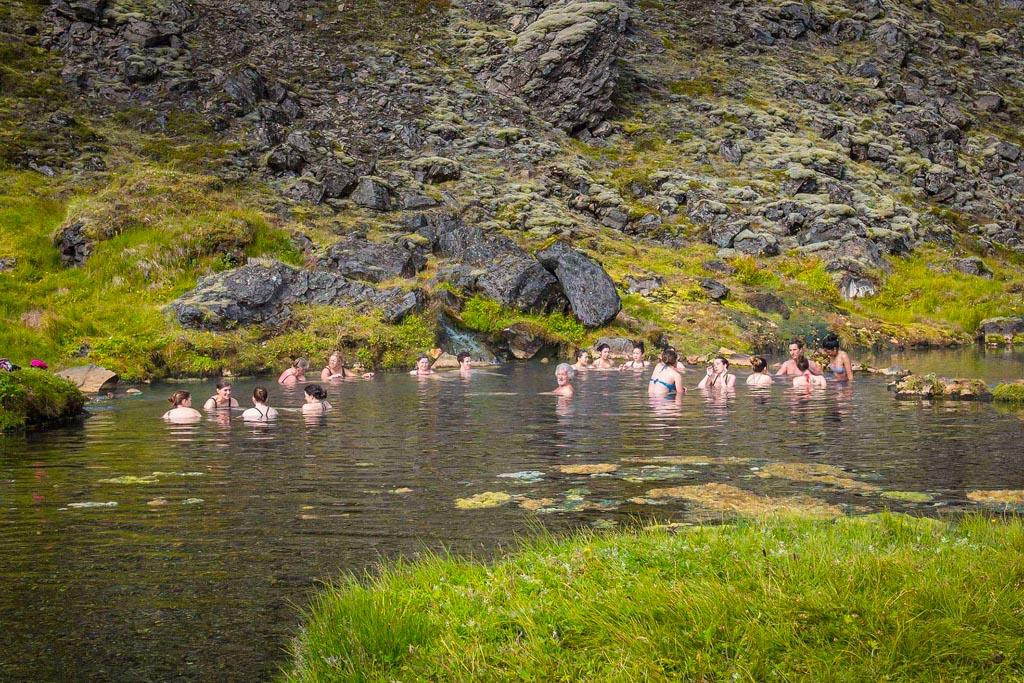
Hikers bathing in the hot spring in Landmannalaugar
Laugavegur trek
From the geothermal hotspots of Landmannalaugar to the glacial valley of Thórsmörk with its lush green slopes, this trek, unsurprisingly, is touted as one of Iceland’s best treks. Covering a distance of 56 km over five days, you’ll experience a kaleidoscope of colours.
Drink in vivid yellow rhyolite rocks and black sand deserts. Enjoy the tales of Icelandic folklore regaled by your guide and learn about the geography and geology of the area. Stay in mountain huts surrounded by the peace and tranquillity of the Highlands and submerge yourself in some of Iceland’s most magical terrains. Book your Laugavegur Trek here.
Difficulty: Challenging
Laugavegur & Fimmvörðuháls Combo
If you don’t want to miss out on the colourful terrain of Laugavegur or the dazzling volcanic landscapes of Fimmvörðuháls, why not book a Laugavegur & Fimmvörðuháls Combo Tour making the best of both? This six-day hut-to-hut hike over 78 km will fully submerge you in Iceland’s stunning nature. Covering so much ground, you will experience a diversity of landscapes: geothermal pools, multi-coloured hills, secluded gullies and great canyons. Experience vivid green valleys and expansive glaciers. This is a hike not to miss.
Difficulty: Challenging
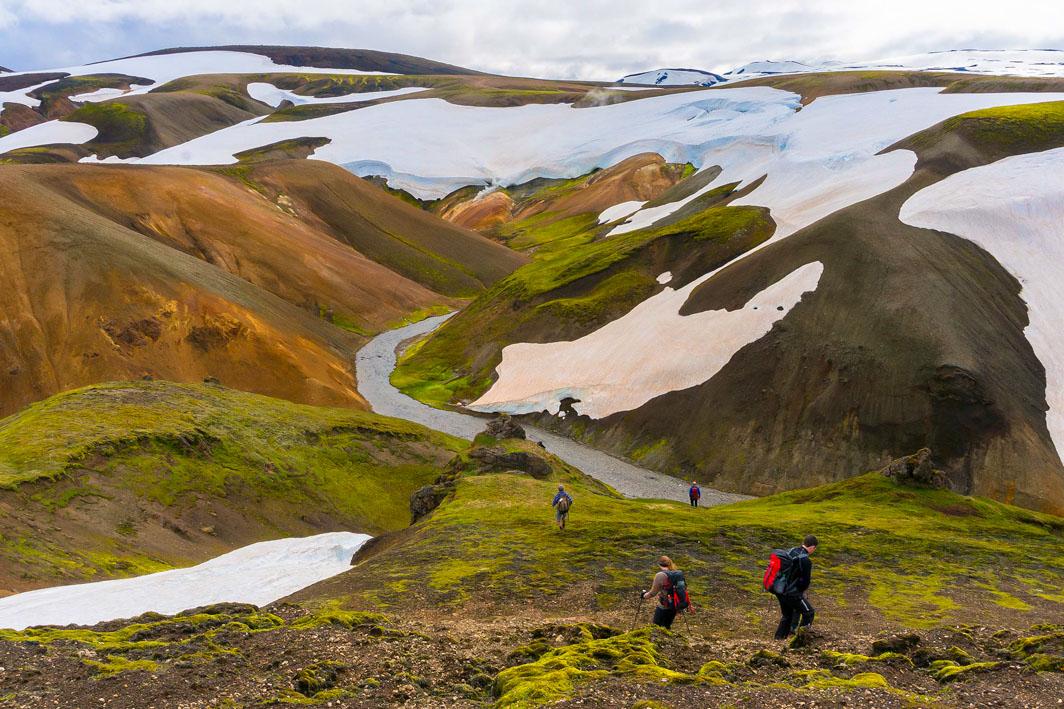
Landscape on the Laugavegur trail
Kerlingarfjöll and the Kjölur route
The Kjölur route hike is one for the hardcore hiker. The section between Hvitarnes to Hveravellir is around 50 km, with four mountain huts along the way offering accommodation on or near the trail: Hvitarnes, Thverbrekknamuli, Thjofadalir and Hveravellir. The trail connects two glaciers, Langjökull and Hofsjökull.
The area around Kerlingarfjöll is one of astonishing beauty. Picture a multi-coloured landscape of green, red and orange hues. This rhyolite landscape will take you alongside hot springs, geysers, steam vents and bubbling and hissing mud pots. A shorter hike (after a bumpy F-road drive-in) will take you through the magical landscapes of Hveradalir.
Difficulty: Strenuous
The Askja trail
Check out Askja Caldera in the Dyngjufjoll Mountains of Vatnajökull National Park. It’s easily accessed from the Ring Road, but up there it feels like you’re a thousand miles from civilisation. The expansive Askja is actually made up of three interlinked calderas. There’s much to pull you into this awe-inspiring landscape: Víti volcano, an aqua-blue geothermal lake, and surrounding lunar landscapes used in training for space exploration.
The Askja trail is a five-day, 100 km hike through the Icelandic wilderness, and it takes through Herðubreiðarlindir, Askja, lake Öskjuvatn with its mystique and history, the crater Víti the wilderness of Ódáðahraun.
Difficulty: Challenging
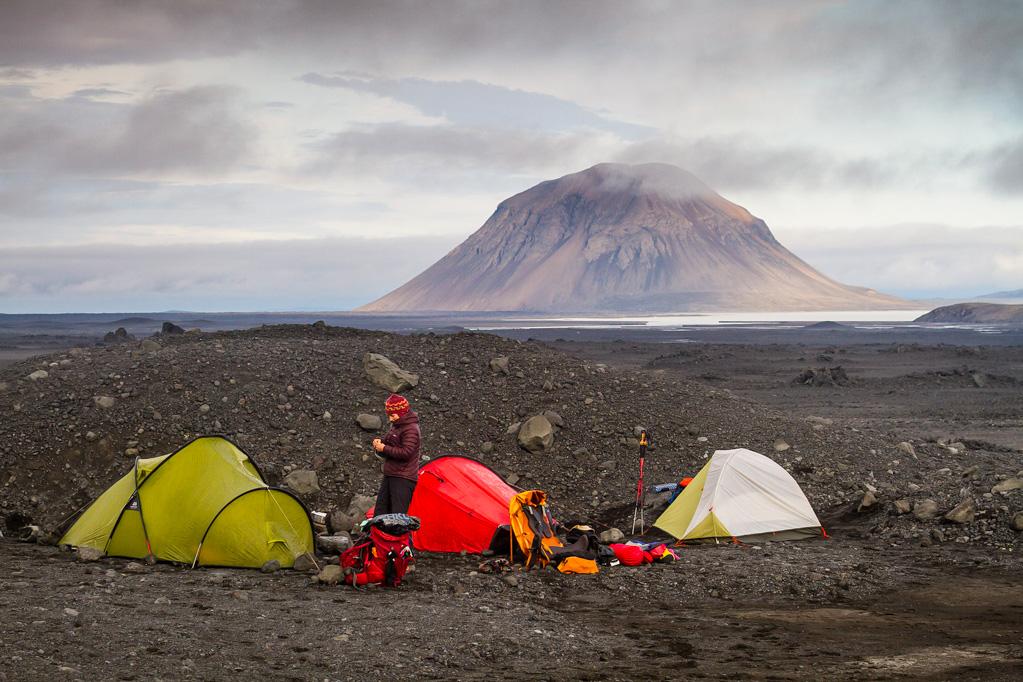
Campers in the wilderness on the Askja trail with Herðubreið volcano in the background
Sprengisandur - Traverse of the Icelandic Highlands
Follow an ancient route (crossing between Hofsjökull and Vatnajökull glaciers) over the wild and deserted landscapes of Sprengisandur to Landmannalaugar. This is a ten-day cross-country ski trip with unpredictable weather, changeable conditions, and unforgiving terrains for the true adventurer. But the rewards make all the challenges more than worthwhile. On this Highland ski trip, you’ll find Iceland both at its rawest and most magnificent. Be awed by wide-open expanses of wilderness. Experience the essence of Iceland in all its glory: snow, ice, fire, and water.
Contact Icelandic Mountain Guides to request a Sprengisandur Ski Tour.
Difficulty: Strenuous
The Best Hikes in the Vatnajökull National Park region
Hiking trails in Skaftafell
Located on the southeast coast of Iceland beneath Vatnajökull, you’ll experience black deserts, glaciers and some of the highest mountains in the country. This is a great trekking area with something for hikers of every level; trails are colour-coded blue (easy), red (moderate) and black (challenging).
An easy hike will take you to Svartifoss (black waterfall) with its striking basalt columns. A similarly uncomplicated hike to Sjónarnípa rewards you with superb views over the magnificent Skaftafell Glacier. For something more adventurous, you can hire a guide and experience glacier hiking. But for the ultimate adventure, conquer Hvannadalshnjúkur, the highest peak in Iceland at 2,110 metres.
Difficulty: Easy to challenging
Hvannadalshnúkur summit hike
From a distance, Hvannadalshnjúkur is a stunning sight, the great hulk of mountain gleaming white, contrasting darker lower slopes and inky forest. The peak is found in the northwest rim of Öræfajökull. You’ll need to hire an experienced guide to climb Iceland’s highest peak. The ascent requires good levels of fitness and mental fortitude, but the views from the top make every gasp for air well worthwhile. From the summit take in the outlet glaciers of Vatnajökull and great sandy plains of the rivers that drain off the glacier.
Here is an Icelandic mountain guide's article about the Hvannadalshnjukur summit hike
Difficulty: Strenuous
If the trek to the top sounds too demanding, Skaftafell National Park beneath the peak is a hiker’s playground. Explore its volcanoes, glaciers, and breathtaking trails, and book a tour of Skaftafell. To plan your perfect trip check out this ultimate guide to Skaftafell.
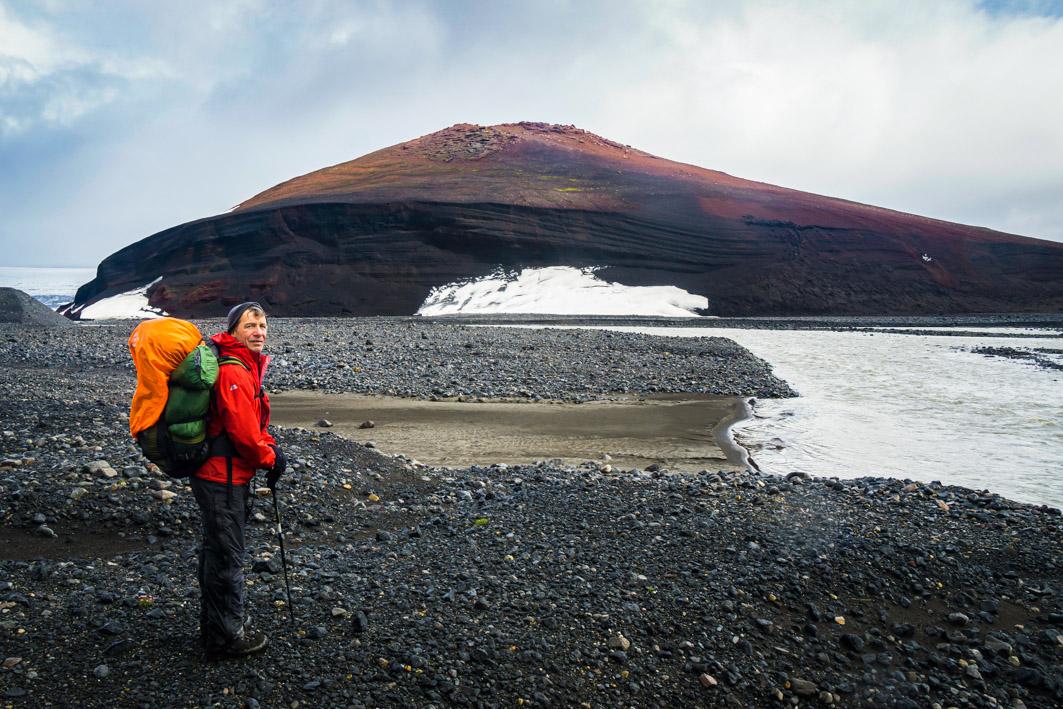
Moonlike volcanic landscape in the Highlands
Núpsstaðaskógar trek
You want to submerge yourself in the best of Iceland’s nature? Book yourself onto this classic five-day trek on Skaftafell. Setting out from Núpsstaðaskógur, head up into the Highlands along the majestic canyons of the Núpsá river with dramatic waterfalls and vertical drops. Contrasting this rocky terrain are the grassy slopes of Sléttur.
Then the scenery changes again with the massive glacier outlet in the next valley. From the glacier of Skeiðarárjökull, you’ll head into the wild river valley of Norðurdalur, hike through the stunning rhyolite mountains of Skaftafellsfjöll into Morsárdalur glacial valley. After crossing an extensive floodplain, you’ll finish at Skaftafell in the national park.
Difficulty: Demanding
Glacier Hikes on Vatnajökull
You’ll need an ice-axe and crampons for this one - and an experienced guide to take you into this winter wonderland (all year round). This four-hour glacier traverse, setting out from Skaftafell Base, is a thrilling experience for the first-timer. Take in the weird and wonderful ice formations and their many hues of white, blue, and grey ash as you walk over the glacier. The outlook from the ice is stunning too. Book your glacier adventure on Vatnajökull with Icelandic Mountain Guides.
Difficulty: Easy to moderate
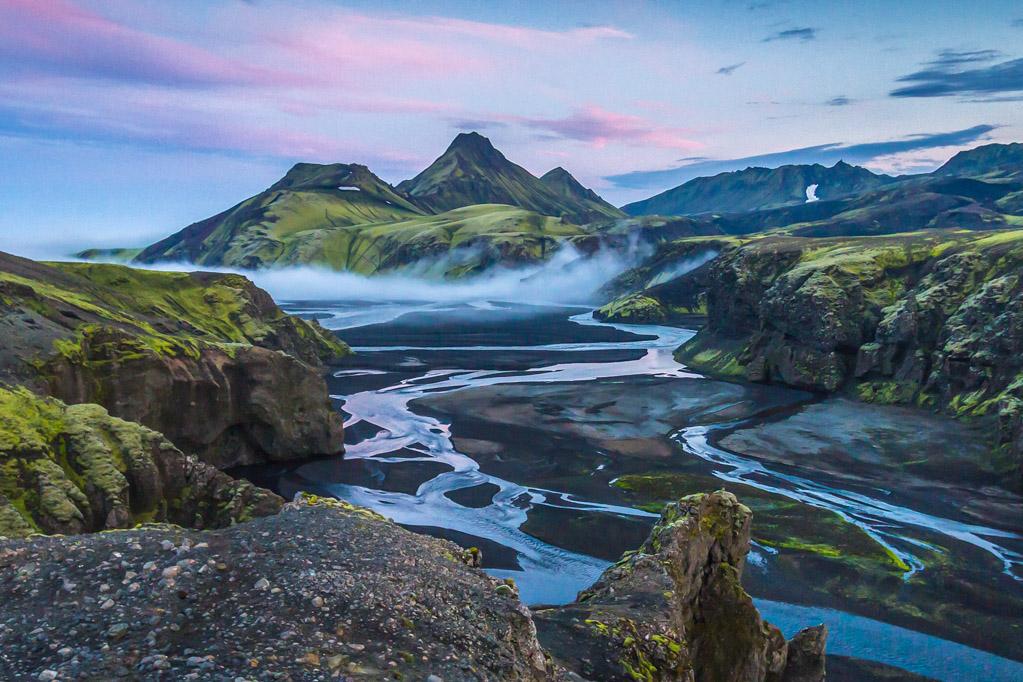
Fantastic landscape in the Highlands under the midnight sun
Lónsöræfi in the Eastern Vatnajökull region
What is it that makes Iceland such a stirring place to hike? It’s the sense of peace and tranquillity - a oneness with raw nature - in the purest of wilderness. The Lónsöræfi hike offers all of this in spades. Experience moraine, lagoon and broad river beds. Hike through deep canyons.
Surround yourself with soaring peaks and dazzling multi-coloured slopes that contrast the snow white of mountain summits and black of basalt rocks. This is a wild and isolated place of rugged hills and sweeping glaciers where reindeer roam. On this four-day hike in the shadow of Vatnajökull, you’ll bunk down in comfortable mountain huts after an energetic 6-8 hours of hiking.
Difficulty: challenging
The Best Hikes in East Iceland
Dyrfjöll and Stórurð hike
Approaching the mountain of Dyrfjöll, you can’t help but be moved by the formidable wall of rock thrusting into the sky with a gaping hole in the middle - hence the peak’s name translating as ‘door mountains’. Starting from the car park by the lake of Vatnsskarð, the distance to Dyrfjöll and Stórurð is around 7.5 km, commencing with a gradual ascent of Vatnsskarð mountain.
Superb views open up northwards to Héraðsflói bay and Lagarfljót River and southwards to Dyrfjalladalur valley. At the end of Vatnsskarðsfyall mountain you drop down to Stórurð, a boulder-strewn landscape dotted with aqua-blue ponds and deep green slopes. It’s a memorable hike.
Difficulty: Moderate
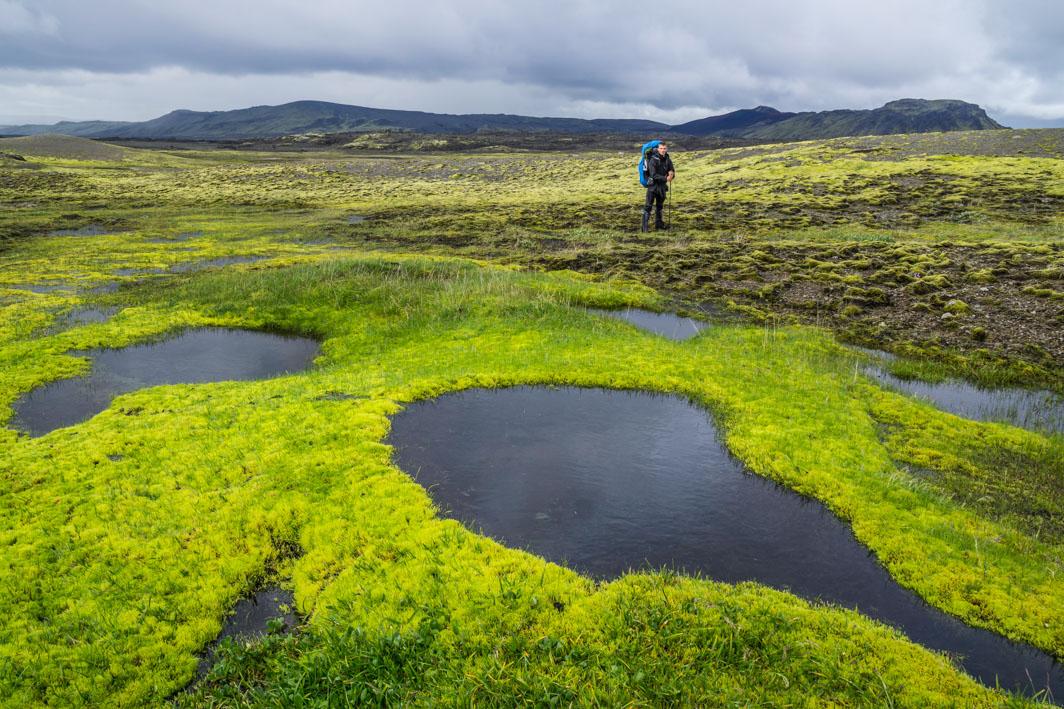
A vibrant mossy wetland
Víknaslóðir Trek
The combination of sea and mountain is a heady one. The Víknaslóðir Trail opens up vistas of black sand beaches and salmon-pink ridges.The five-day hike takes you along old trails that link isolated cove with isolated cove alongside secluded fjord.
The lower-level paths hugging the east coast mean milder temperatures - always a bonus - with the soothing sounds of the Atlantic surf as you drop down to the sea. Meander below snow-patched peaks and through colourful hills. On this five-day trek you’ll rest up in rustic but comfortable mountain huts.
Difficulty: Challenging
Mt Snaefell Hike
From the car park at Snæfellsskáli hut, the trail heads up a steep but smooth track initially. At 1,833 metres, Snaefell (snow fell) is the highest free-standing mountain in Iceland outside the glacier region, and on the approach it’s a spectacular sight. The trek to the summit is a challenging eight-hour round trip that should only be attempted with an experienced guide with all the equipment needed for high-level climbing.
But have no fear; Icelandic Mountain Guides will get you safely up and down. The conditions are changeable and mists can descend very quickly. Even in summer, there are parts of the mountain where the snow never melts. The views across East Iceland are superb if you conquer the peak in clear weather.
Difficulty: Challenging
The Best Hikes in South Iceland
Glacier Panorama Trail
If you prefer the ease of travelling downhill (in the main), join the Glacier Panoramic Trail tour with Icelandic Mountain Guides. Start your adventure with a ride in a glacier truck from Sólheimajökull car park, taking you to 750m on the glacier of Mýrdalsjökull.
In this wild and isolated place, you’ll hike above the outlet glacier of Sólheimajökull. This is a world shaped by volcanic activity: sculpted and layered rocks of ash and basalt, the outlet churned up with ice and choked with plains of glacial outwash deposits. Contrasting the pure white world of the glacier are the valleys of dark basalt cliffs and slopes of vivid green mosses and grass.
Difficulty: Moderate
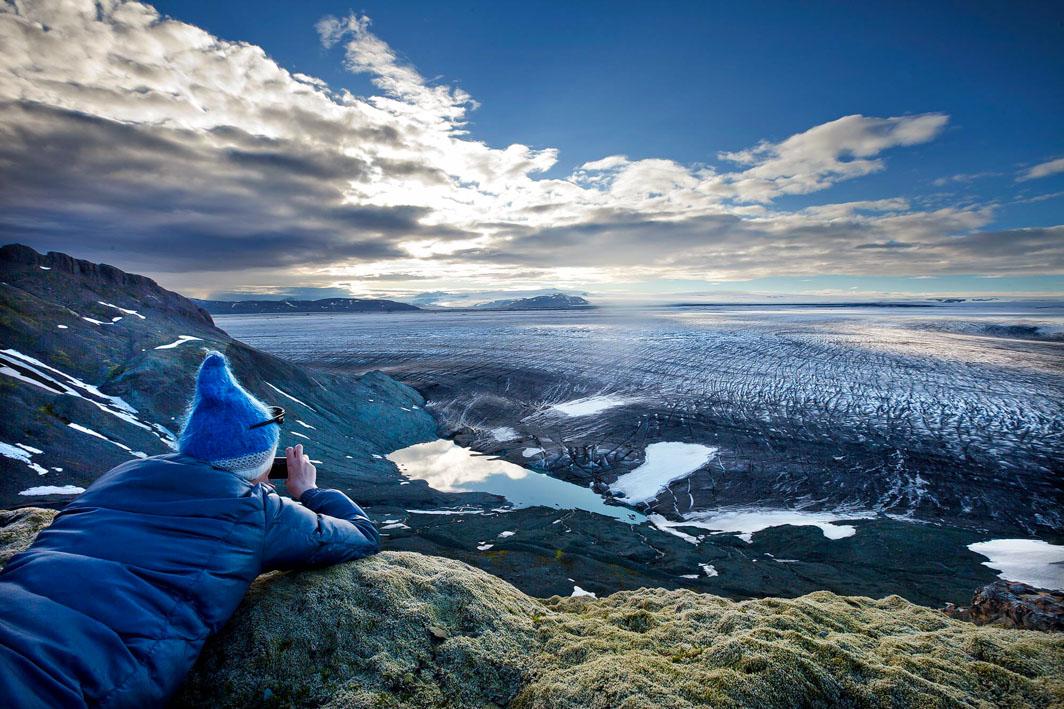
Viiewpoint over a glacier in Skaftafell
Reynisfjall mountain hike near Vík
This is a 7km hike of pure delight. The views across to Vik, the black sands, sea stacks at Reynisfjara and arches at Dyrhólaey are breath-taking as you walk paths that drop away to the Atlantic Ocean. Choose a calm day with little wind and clear visibility; this will be a moderately easy walk.
Follow the broad service track, then take a left along a grassy path once past a gate, following the markers to make a loop before retracing your steps along the service road. Apart from the panoramic coastal views, highlights include the seacliff bird colonies and the Cell tower.
Difficulty: Moderate
Thakgil
Jagged canyons of mossy green, black sands, glistening glaciers, waterfalls, broad river plains with ribbons of meandering streams and far-reaching views of Iceland’s otherworldly volcanic landscapes - Thakgil has it all. And even better without the crowds of the honey pots.
Take your pick from four trails: a very short but sweet ravine trail (300 metres) from the campsite; the Remundargil Ravine purple trail - 12.5km; Austurafréttur Range yellow trail - 17km and Mælifell red trail - 13.5km.
Difficulty: Easy to demanding
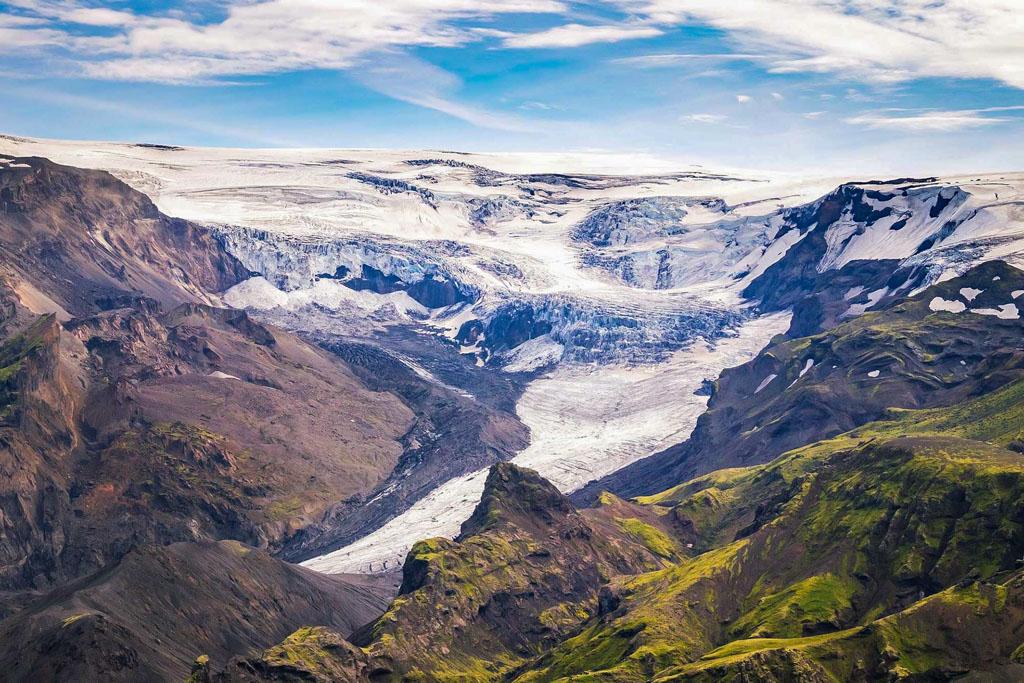
Scenic view in Vatnajökull National Park
Reykjadalur hike
Unlike Thakgil, the Reykjadalur hike is extremely popular due to its close proximity to Reykjavik and because of its ‘Hot River’ with geothermal bathing pools set into a mountain canvas of the grey-brown and green and darker screen. As you head up the valley beside the brook, strange sounds emit from fumaroles - hissing, plopping, and gurgling - while steam drifts across the path from the geothermal river. This is an atmospheric place.
The 3.5km path is easy underfoot; boards and steps in places help to make the going easier and to protect the environment. With so much footfall on this popular trail, keep to the path. The steady ascent will bring you to pools in the river where you can bathe - just the right temperature for the human body.
Difficulty: Easy to moderate
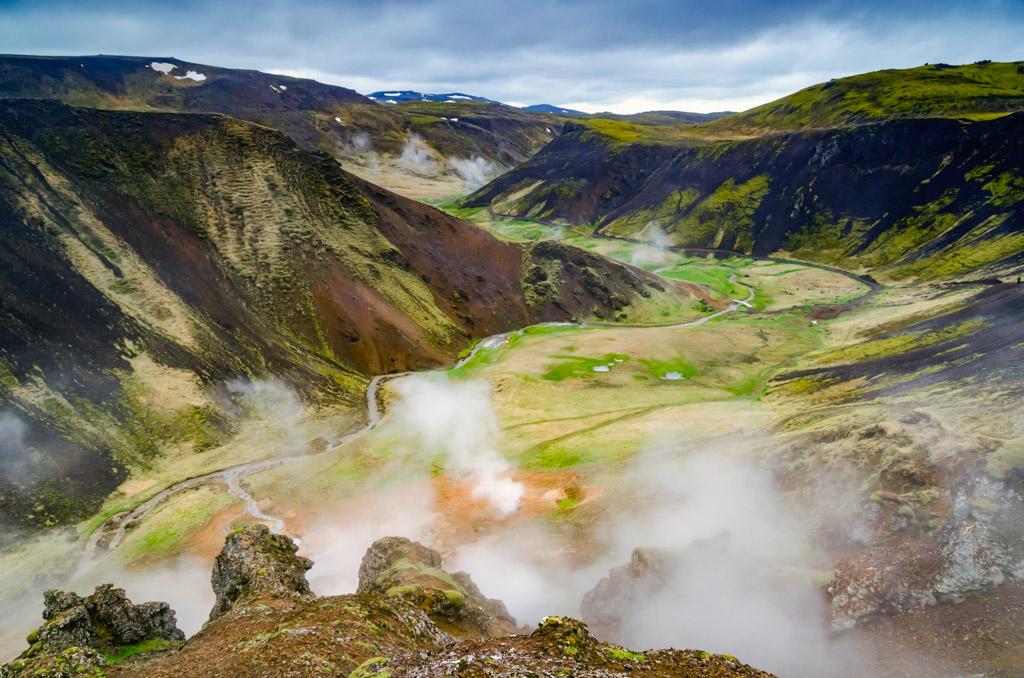
Smoking hot springs in Reykjadalur valley near Reykjavík
Great hikes in the Hengill volcanic area
Smack right in the middle of Iceland’s west volcanic belt, Hengill is a dream landscape of hot springs, craters, tumbling rivers and smoking geothermal waters in rich green valleys of diverse grasses, mosses and herbs. A variety of trails set out from Ölfusvatn, Dyradalur, Nesjavellir, Úlfljótsvatn and Hveragerði.
Information boards give trail distances and points of interest along the way. The map of the Hiking trails at Hengill area will help you choose the best route for you: the blue-coloured main trails mark out easy routes; the red-coloured trails also provide short connecting pathways and black-coloured trails take the hiker up steep gradients with fantastic outlooks.
Difficulty: Easy to demanding

A solo female hiker
The Best Hikes in West Iceland
Arnarstapi - Hellnar
Departing from the fishing village of Arnarstapi, wander along the coast to Hellnar via Gatklettur with its fascinating rock formations, just over three kilometres in one direction. Along the way, take in mossy lava fields, a sea cave, sea stacks, off-shore islets, intimate bays and vertiginous basalt columns. Spring and early summer is a great time for bird-watching and wildflower enthusiasts.
Difficulty: Easy
The Snæfellsjökull Summit Hike
You know you’re in for a treat as you approach Snæfellsjökull to start your climb, the great hulk of glacial mountain glistening white. The setting Jules Verne chose for his epic “Journey to the Centre of the Earth”, the glacier rises 1,446 metres from sea-level.
On the summit, views extend to Reykjanes Peninsula in the south and towards the West Fjords in the North. You’ll be provided with all the necessary equipment for ice climbing including crampons and rope. Book an exhilarating ascent of Snæfellsjökull with Icelandic Mountain Guides by private arrangement.
Difficulty: Demanding
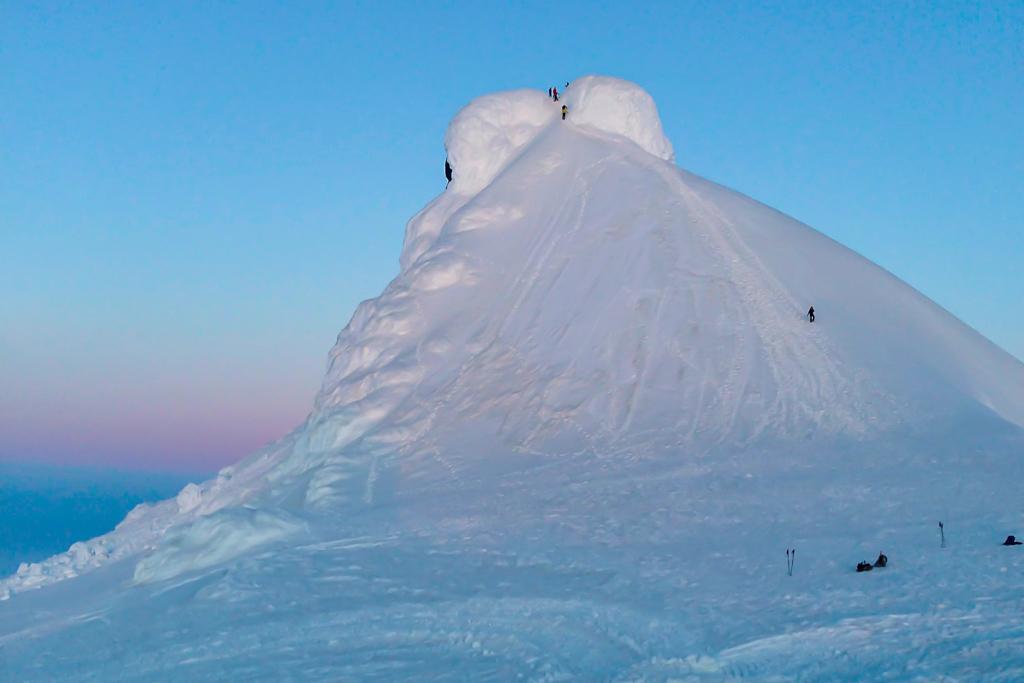
The Snaefellsjökull summit
Glymur hike
This is a beautiful walk up to Glymur Waterfall through a lush green valley along the Botnsá River. You can do a there-and-back or a loop. The circular walk is just over 7 km. Pass through a wide cave and traverse the river, using the wire support to cross the river boulders then a log.
The views above the canyon are spectacular as is the waterfall. Cross the wide and shallow river above the waterfall (bring extra shoes or go barefoot), then follow the markers back to the carpark (with two similarly distanced options).
Difficulty: Moderate
Fagradalsfjall volcano hike
Fagradalsfjall may have gone quiet but caution is still required. Not far from the Blue Lagoon, and only twenty miles from Reykjavik, the fourteen-kilometre circular hike starts out from Fagradalsfjall car park and takes you through the solidified lava of the 2021 eruption, then the more recent lava flows of the 2022 eruption.
The lava is still very hot in places; keep to the route. After an easy gravelled section, the last part of the ascent crosses a lava field of tricky volcanic rocks and mud. Things may be quiet for the moment but this is still a thrilling hike through a lunar-like landscape.
Difficulty: Moderate

Hikers watching the volcano erupting in 2020
The Best Hikes in Iceland’s Westfjords
Látrabjarg hike
This is an exciting 7 km there-and-back ramble along the cliff tops of the most westerly point in Iceland. It boasts the largest sea cliff in Iceland. Along the way, you have a chance to see razorbills, guillemots, kittiwakes, and, most thrilling of all, puffins.
Difficulty: Easy
Hornstrandir Nature Reserve
Tucked into the most northwesterly corner of Iceland and only accessible by boat in summertime, you need to make a special effort to reach this wild and remote nature reserve, but boy is it worth the effort! One of Europe’s last true wildernesses, the landscape is simply stunning. Picture thundering waterfalls and jagged cliffs that plunge to the water - all overlooked by the snow and ice of Drangajökull.
The ground underfoot is challenging when hiking, and mists can roll in without warning. You’ll experience everything from snow, mud, uneven stony ground to ice-cold rivers (you’ll have to ford) and steep inclines. You’ll need a compass, GPS and map - and the skills to use them. But this is a magical place, where you’ll encounter all sorts of wildlife including the Arctic fox.
Difficulty: Demanding
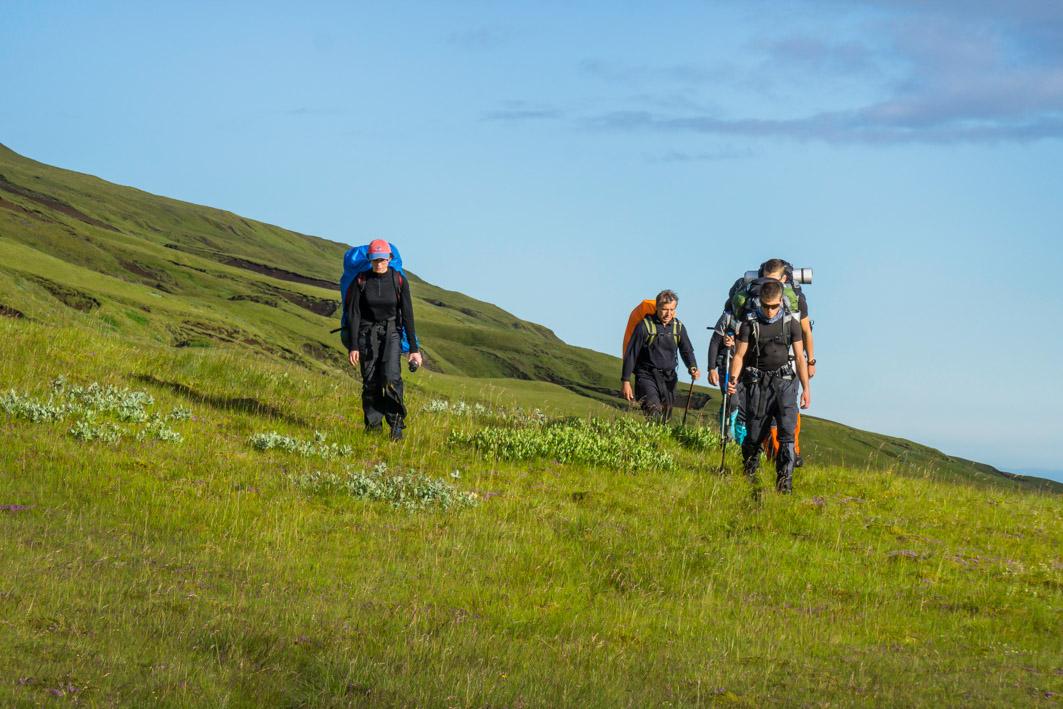
The Best Hikes in the Reykjavík capital area
Esja
The almost 8-km hike near Mosfellsbær ascends 700-odd metres. You can walk as far as Steinn (meaning rock) year-round and loop back to your starting point, but in summer don’t miss the climb to Þverfellshorn, a volcanic range of tuff and basalt with superb views of the sea and Reykjavik from the top.
Difficulty: Easy to Moderate
Keilir
A 7km there-and-back hike, the trail is easily accessed from both the airport and the capital. From its 379-metre summit, you can pinpoint the steaming Blue Lagoon, the Atlantic, the glacier of Snæfellsjökull and Reykjavik with its satellite settlements. The first part of the walk over mossy tundra and grasslands interspersed with rocks - great for birdwatchers - is not too tricky. Higher up, gravelly rock underfoot means you need to watch your step, but the mountain thrusting out of flatter land is not as tough as it initially looks.
Difficulty: Moderate
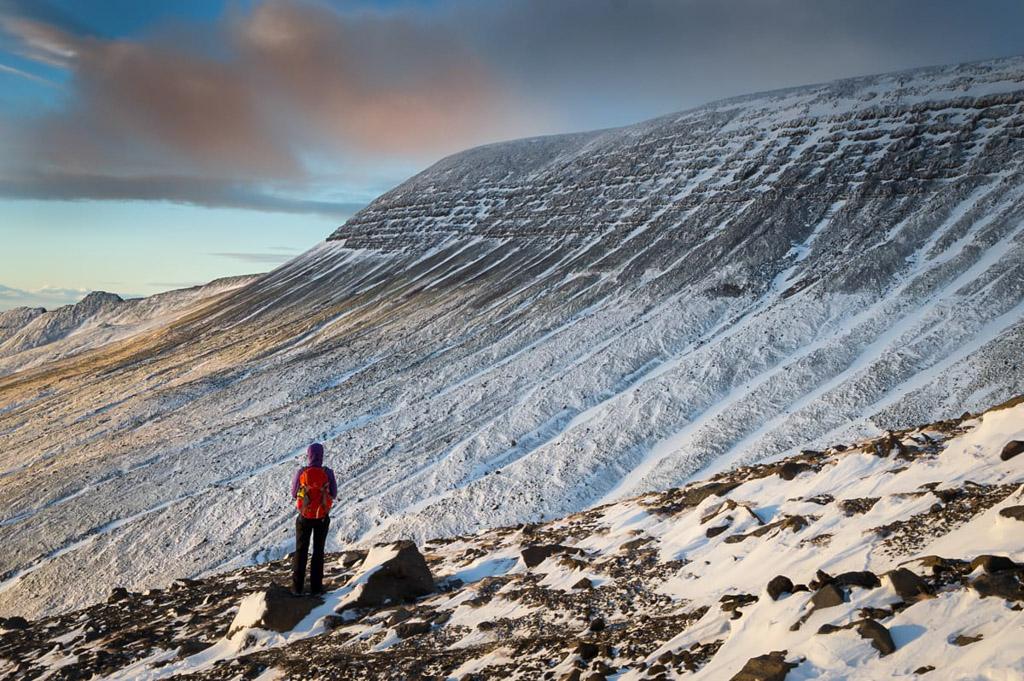
Mount Esja in winter
Vífilsfell
Close to Reykjavík, this there-and-back 6-km walk in total is short but not without its challenges. Easily accessed from Reykjavik, the trail climbs through the valley of Jósepsdalur on the volcanic plateau of Hellisheið. It’s a beast of a climb requiring good fitness and balance along the ridge and on the approach to the summit at 655 metres with some scrambling required at the top. Pick a clear day and you’ll be well rewarded with superb views of the surrounding volcanic landscape.
Difficulty: Moderate to challenging
Moskardshnjukar
Starting out from the trailhead at Móskarðshnjúkar, there’s a sustained ascent requiring a good level of fitness. The clearly marked trail heads through bright rhyolite terrain, crosses scree slopes before climbing steeply to the summit at 800 metres. Pick a day with good visibility for fantastic 360° views.
Difficulty: Moderate
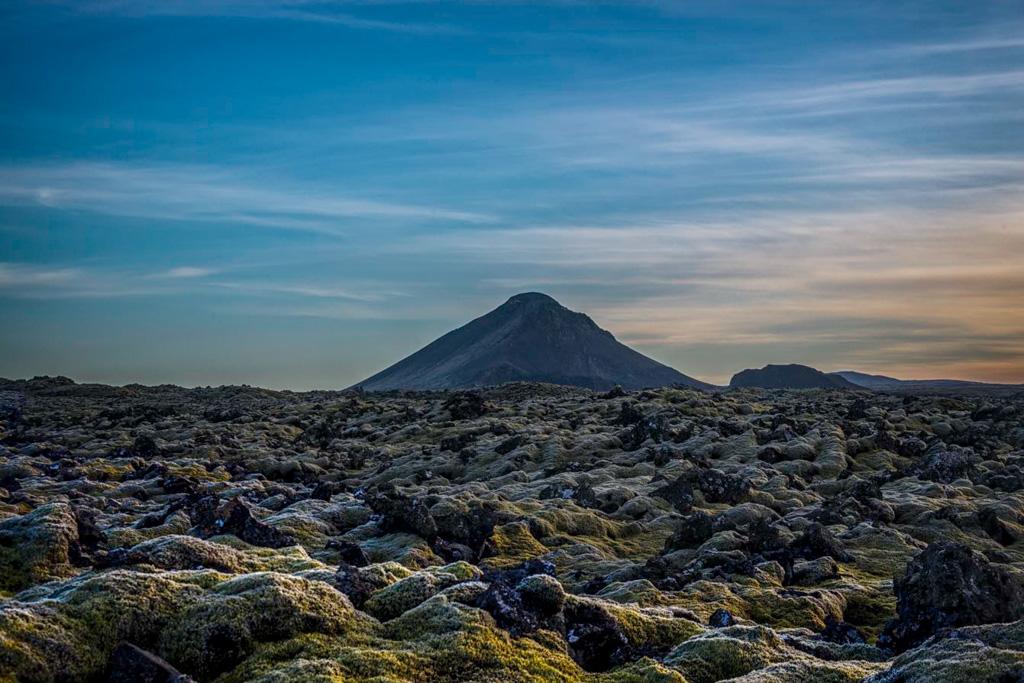
Mount Keilir. Photo: Ævar Guðmundsson on Flickr
The Best Hikes in Iceland on an Interactive Map
Check out this interactive map to see what’s on offer across Iceland at a single glance; perfect for anyone getting to grips with the geography of the island.
Safety and precautions while hiking in Iceland
- Make sure you are properly dressed for the changeable weather and cold and windy conditions - wear layers, with a thermal underlayer, sturdy waterproof boots and jacket. Add a hat and gloves.
- Always carry a compass and map - and learn how to use them.
- Check the local weather forecast before setting out.
- Download safetravel.is to get up-to-date reports on the weather as well as road and trail closures.
- If you are walking alone, always leave your route with your accommodation.
- Never set out without water, food and a first-aid kit and phone GPS
- If you are an inexperienced hiker, book a guided tour for peace of mind
Your questions answered
What is the best month to hike in Iceland?
From May to September you can book superb treks with Icelandic Mountain guides. June, July and August are the optimal months.
What is the toughest hike in Iceland?
There are many hikes that will challenge the most adventurous hikers. Test your mettle with an ascent of Iceland’s highest peak, Hvannadalshnjúkur or the alpine trekking route up the four peaks of Hrútsfjallstindar. Or how about the Three Peak Challenge of Vörðuskeggi, Eyjafjallajökull Glacier and Hvannadalshnúkur? Alternatively, hike the largest glacier in Europe or ski across the Highlands at Sprengisandur. Take your pick!
Can you hike in Iceland without a guide?
It depends where you’re hiking. Do your research. You'll need a guide if you’re climbing difficult mountain routes or traversing dangerous glaciers. For inexperienced trekkers, always book a tour. Alternatively, allow Icelandic Mountain Guides to do all the work by providing you with a guided hike.
Is Iceland's glacier hiking worth it?
Absolutely. Surrounded by beautiful scenery, it’s a fantastic experience. In the care of an experienced guide, you’ll find an otherworldly environment of deep crevasses, sparkling hues of blue and white, crazy ice formations, and an expanse of ice dazzles the eyes.
Should I wear hiking boots in Iceland?
Yes, yes, and yes! The mountain terrain is rocky, wet, or covered in ice and snow. You’ll also want good support for your ankles on uneven ground and sloping hillsides. Wear a thick pair of socks under your boots for maximum comfort.
Can you wear sneakers for hiking in Iceland?
Unless you’re walking a short distance in Reykjavík, sneakers are not suitable. Hiking requires strong waterproof boots across all four seasons.
What are the easiest hikes?
You don’t have to be a mountain goat to experience Iceland’s awe-inspiring landscapes. Take an easy guided glacier hike on Sólheimajökull, a stroll up to the Steinn (rock) at Esja, just ten kilometres from Reykjavik, or trek along the wonderful Hot River of Reykjadalur, finishing with a soak in the geothermal pools.
How difficult is the hike to Fagradalsfjall?
For inexperienced walkers, the route to the recently active volcano is challenging; for more experienced hikers only moderately difficult. Loose gravel and rocks make going underfoot tricky, and the terrain is steep.
Is there still lava in Fagradalsfjall?
Although the lava is no longer flowing, it’s still hot, and caution should be taken. The way is sign-posted, so stick to the paths, and you can still experience the smoking lava fields in all their eerie magnificence from a safe distance.
Do you need a tour to see Fagradalsfjall?
If you’re an inexperienced hiker, it’s best to take a tour, and you’ll have the knowledge of a local guide. For more experienced hikers, you can do it yourself.
How many days is enough for Iceland?
No amount of days is ever enough in Iceland! But if - like most of us - you’re restricted to a handful of days, there are plenty of options for short hikes close to the capital or on the Golden Circle with waterfalls and hot springs. If you’ve two or three weeks, the options on Iceland’s Ring Road (circumnavigating the whole island) are endless. To experience the best long-distance hikes in the Highlands, build in multiple days for your trek.
For the ultimate trekking experience, hike in Iceland with Icelandic Mountain Guides. They will answer all your questions and provide the comprehensive information you require: the geology and geography of Iceland, tips for hiking, and a wide range of self-guided and trek-led single and multi-day trips.
Keep me informed about the Icelandic Mountain Guides Blog
Outdoor adventure in Iceland is our specialty. Subscribe to our free monthly newsletter to learn when to go, what to do and where to have the best adventures in Iceland.
Related Blog Posts
Related Tours
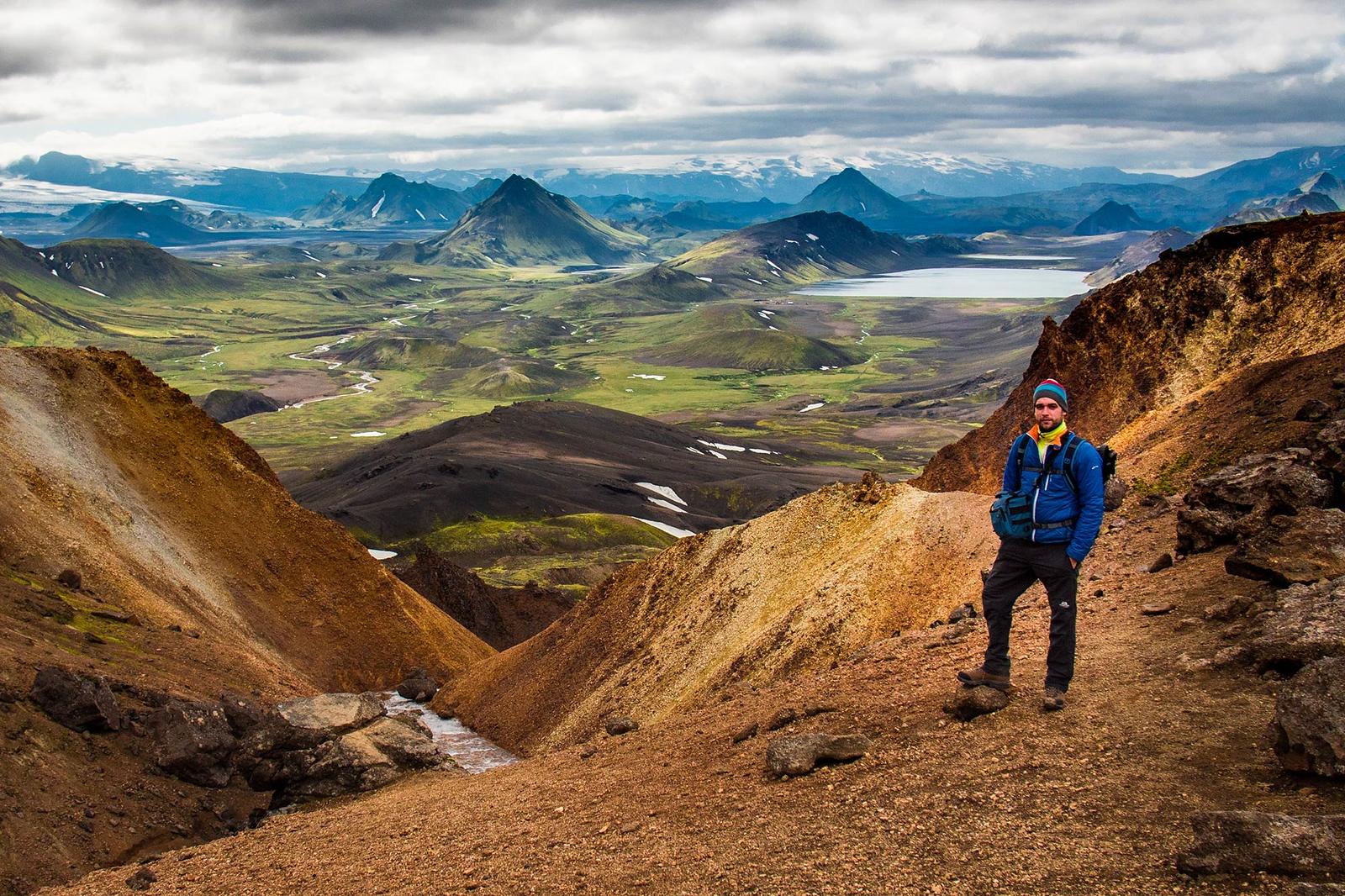
Laugavegur Trail - Self Guided
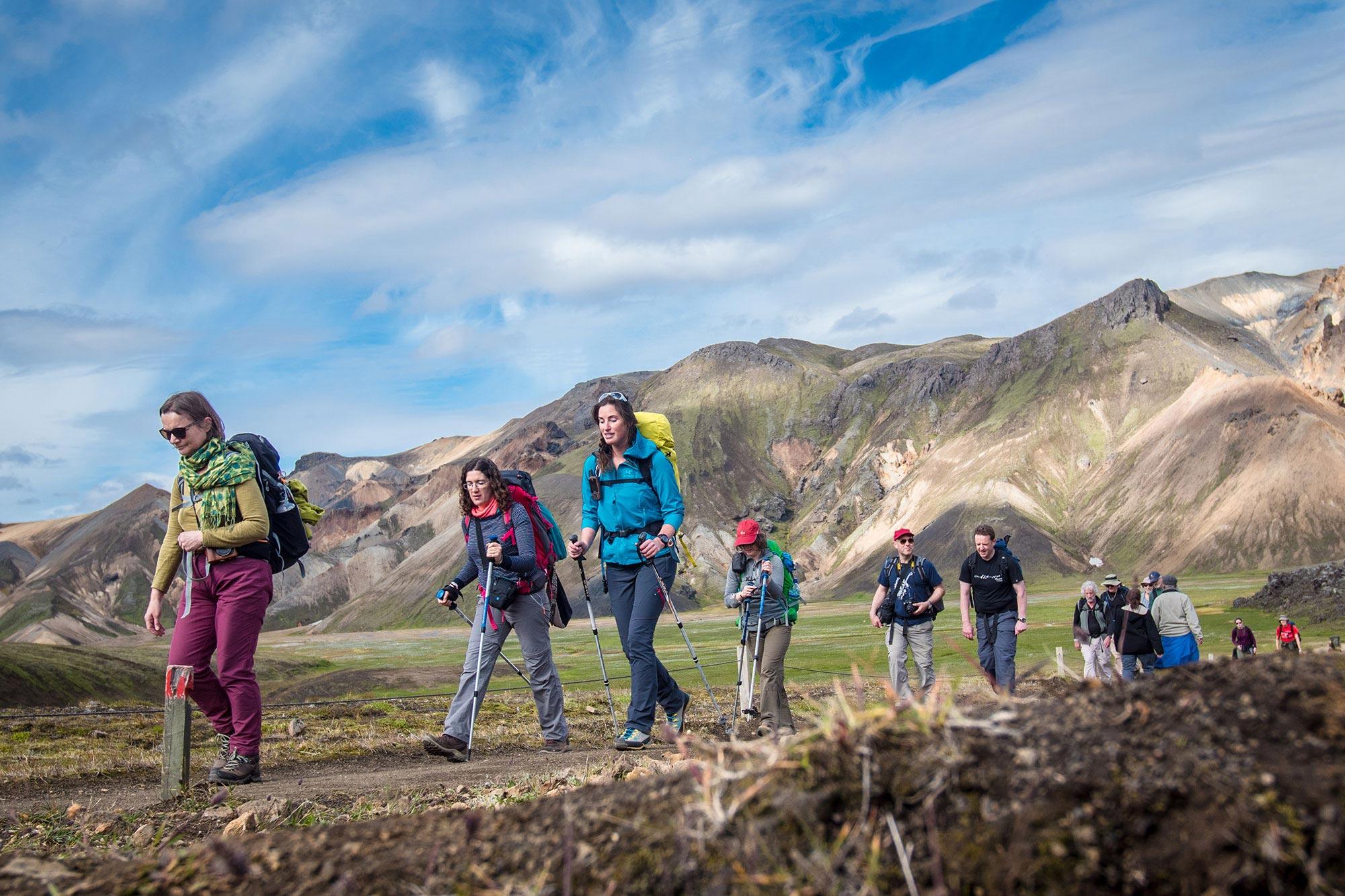
Laugavegur Trek Classic (Huts)

Hvannadalshnúkur - Iceland’s Highest Summit
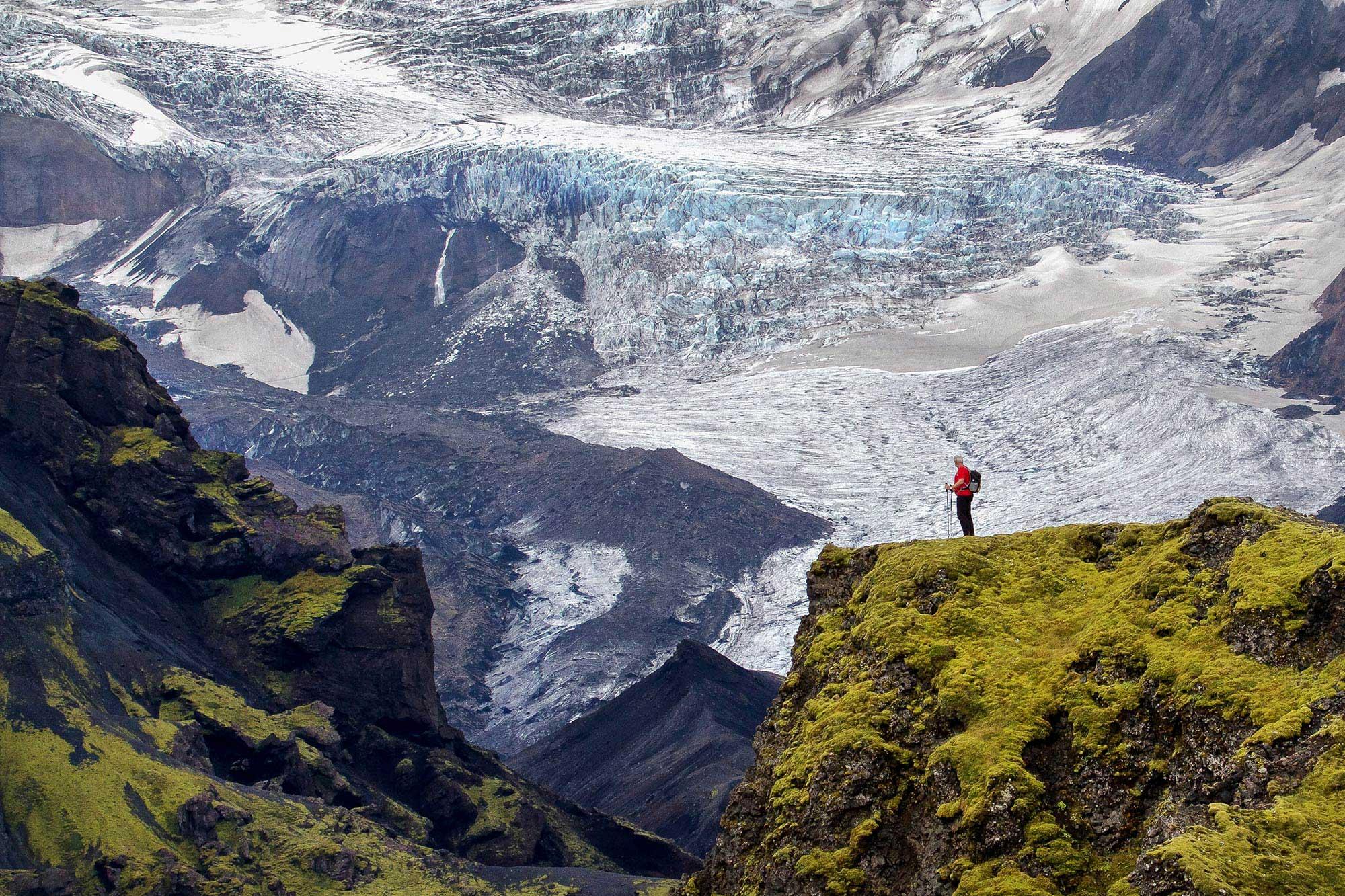
Laugavegur & Fimmvörðuháls Combo Tour
